Today, Global Security Operations Center as a Service (GSOCaaS), the strategic merger of technology solutions to meet physical and operational security needs delivered as a managed service, is an accessible solution that smaller to large businesses are tapping into. Just five to 10 years ago, GSOCs were expensive and proprietary to Fortune 500 companies, financial services companies, large high-tech companies, and governments.
Why has GSOCaaS gone mainstream? In today's complex world, real-time situational awareness is critical for security and facility management professionals to make decisions regarding the security of assets and operational continuity on a daily basis. Companies demand the latest in threat intelligence capabilities and response tools, web and social media monitoring, mass notification communications, and workforce management platforms to provide additional layers of situational awareness and responsiveness to their security operations. The cost of creating and maintaining an in-house GSOC could cost millions of dollars, and requires highly trained experienced personnel. By turning to a service partner, companies are able to integrate security intelligence and analytics with cloud-based, flexible and scalable platforms that integrate into a company’s security program to improve situational awareness and human response at a budget they can manage.
Advent of COVID-19
The advent of COVID-19 increased awareness about security program gaps and vulnerabilities. The pandemic resulted in questions, requests, and concerns from existing and new customers to GSOC operators and GSOCaaS managed service providers. As could be expected, the outcome has been GSOCaaS providers adding new customers to the mix and increasing the services from existing clients. Many companies had to close or limit their business and required additional video and/or intrusion monitoring – many moving to 24/7 – to ensure that their comprehensive security goals were met. More security and facility managers recognized that COVID-19 created additional vulnerabilities and risk and understood the value of video monitoring. In addition, companies with existing Command Centers looked to Monitoring & Response Centers for back up and support with expanded demand, risk assessment and communication as this pandemic created demand and stress tests at all new levels.
Companies who did not have as many, or any, people on-site to keep their premises secure, found gaps and vulnerabilities in their current program and began turning to GSOCs to add additional cameras and hardware, and monitoring as an alternative to fill those gaps. Sites with unanticipated vacancies and vulnerabilities, some of which required additional technologies, including the use of Rapid Deployment Solar Video Surveillance platforms.
The “new normal’’ in video monitoring will be that more companies than ever before will consider how to leverage video surveillance systems to prop up a business that cannot operate normally. Companies are now evaluating if the people or person who handles the security-related equipment gets sick, who will step in and fill that critical need? What is their contingency plan if people are too sick to come back to work? Companies that have in-house video monitoring are looking at remote video monitoring. However, moving video monitoring from in-house to remote is not a simple process that can be taken over at a moment’s notice. The GSOCaaS integrator needs to learn their systems, products and processes so it requires thoughtful planning.
Thermal Cameras Become Part of ‘New Normal’
As a trusted partner, we have been helping our clients prepare for the ‘new normal’ with COVID-19. As part of this, we are sharing best practices, guidance, and tools during this crisis to help businesses provide a safe, virus-free environment. Part of this guidance includes temperature pre-screening services for occupants entering the property that is tailored to the facility. Companies need to be prepared for employee and visitor screenings, which require varying levels of equipment (temperature gauges, physical barriers) and personnel protective equipment. Thermal imaging cameras are used to scan temperature from a safe distance, and if a fever — a common coronavirus symptom — is detected, further screening is required. Thermal cameras are becoming the ‘new normal’ for many enterprises.
An interesting application of remote video for COVID 19 mitigation strategy is the use of analytics-enabled cameras on a fixed position AI unit. The unit can report the detection of persons entering or leaving rooms in a temporary hospital used for indigent persons who are quarantined. The detection unit is able to flash warning lights and broadcast a message letting anyone in the area of detection know they were in a restricted area and patients should return to their rooms. Anyone else should immediately leave the area. They were under surveillance and authorities would be notified.
As more and more companies are considering GSOCaaS, what are the essential components they should be looking for that enable greater situational awareness for proactive risk mitigation, reactive response and incident management? Essential features include:
- Physical Security Monitoring & Response at Site
Physical security has traditionally been the primary focus of corporate GSOCs. The first generation GSOCs all provide staff monitored video feeds, sensors, and alarms and oversee access control systems of perimeters, restricted buildings and other spaces. As security programs become more complex, more and more companies are tapping into more sophisticated pieces of the security monitoring puzzle. Acceptable threat detection and response requires 24/7 staffing of security professionals capable of investigating, triaging and responding to indicators of compromise in real-time.
- Situational Awareness & Threat Intelligence
Through cloud-based platforms and workforce management and collaboration tools, insights are aggregated and analyzed from thousands of data sources and delivered directly to the people in the organization who need them to better mitigate risk and make more informed security and business decisions. Security operators are able to make faster, more informed decisions with highly relevant, real-time alerts and a comprehensive common operating picture of intel from around the world or down the street.
Visibility and insight into online risks across an entire organization can be delivered to the people who need it, when they need it, through platforms that scour the web, dark web and social media. By using a combination of artificial intelligence and machine learning technologies and U.S. intelligence agency best-practices, these platforms can identify risks to notify of potential threats in real-time.
- Critical Event & Incident Management
Using a combination of real-time analytics, event-based technologies and threat intelligence, security intervention specialists can provide 24/7/365 monitoring for a variety of situational intelligence capabilities. A Monitoring and Response Center can process a variety of alert types and provides end-to-end, proactive solutions to enhance situational awareness and mitigate risk while reducing operational cost. Specialists can custom-design intrusion detection (fire and burglar alarm) systems that integrate into the response protocols processed through a Monitoring & Response Center to meet a company’s specific needs. These services can be added to an existing security program as a force-multiplier or installed independently to help mitigate risk and reduce cost by deterring break-Ins and burglaries, reducing theft, preventing property loss and damage, and providing a safer and more secure business environment.
In the event of a crisis, the primary response is usually to contact local police or fire departments for emergency assistance. Since the average police response time varies across the country, access to additional safety resources that can respond to or monitor events immediately is crucial. A GSOCaaS can help by dispatching security professionals, recording events, and remotely securing points of entry such as doors, gates and windows. The GSOC also acts a centralized communication hub during an emergency or crisis event. For example, with an active shooter situation, a GSOC with video monitoring and firearm detection capabilities can identify a shooter from the first shots, dispatch police emergency services, remotely lock doors and windows, and send out mass communication to hide or take cover. The GSOC is continually monitoring and analyzing the data it receives and takes suitable action.
- Event-Based Video Monitoring
Most video monitoring is event-based which takes advantage of advanced video analytics software and sensor-equipped cameras that trigger human reviews following a set of defined protocols. Across the industry, a smaller percentage of video monitoring work involves live, real-time monitoring using trained security professionals.
Leveraging video analytics with real-time, event-based monitoring by security intervention specialists offer company solutions that are scalable, reliable, and efficient and deter theft and mitigate the criminal element.
- Travel Risk Advisory
If a natural disaster, terrorist attack, or other emergency events occur while an employee or contractor is traveling for business or personal reasons, a GSOC is able to provide resources in a time of crisis and even provide evacuation assistance. Smartphone apps, such as LiveSafe, make reporting safety or security events as easy as pressing a button with reports sent to the GSOC and visible on a live dashboard, with security professionals able to monitor in real-time. While traveling, the platform is able to dial the correct local emergency services number for employees, depending on the GPS-determined location. It can also provide local travel information, such as if a train or bus strike is occurring. A GSOC can monitor local activity and send a push notification to everyone in a specified geographic location that has the app downloaded. The app can also be used to alert the GSOC to individual events. For example, if an employee loses their passport, they can use the platform to report the incident so that the GSOC may assist in getting a new or temporary one to travel home.
- Digitizing Operating Procedures/Critical Event Management
Digitizing manual and disjointed policies, procedures and action plans can simplify team coordination during both routine and emergency incidents. It also creates a common operating picture across dispersed operations and response teams, keeping them synchronized throughout the life cycle of any situation.
- 24/7 Security Support
Today’s companies generally believe that their duty of care and potential risks extend beyond working hours. A GSOC is able to provide 24/7 monitoring of a company’s assets (facilities, employees, etc.). For example, if an employee stays late to finish a project, the GSOC can act as a virtual escort by either staying on the phone with the employee or video monitoring them as they walk to the car. Similarly, if an employee is leaving the office and notices a suspicious person or package or a facilities issue like a water main break, the employees can notify the GSOC at any time.
Managing the Risk
Crises are inevitable but knowing how to respond to them is a critical risk mitigation strategy that can save lives. GSOCs provide crisis management training and planning prior to an event. For example, if an employee lives in Sugar Land, Texas, or the Bay area, flooding and earthquakes are possibilities. As acts of nature like earthquakes and floods are unpredictable events, knowing how to properly respond to them is crucial, so flood and earthquake drills are an effective form of preparation. Practicing evacuation routes and plans provide peace of mind for employees and alert the GSOC to potential issues in the plan before the event occurs.
A GSOC can also aid in the recovery process. Having procedures in place and operators who are trained and familiar with these policies will help the crisis recovery flow as smoothly as possible.
Emergency and crisis communications need to be clear, direct, and centralized. Incorrect information can spread if effective means of communication is not established prior to an event, or if employees don’t have a centralized source to get their information from. A GSOC acts as the centralized point of contact for both incoming and outgoing information, removing bottlenecks and confusion, and providing a quicker and clearer way to communicate.
About the Author: Sherman Brawner is Vice President & General Manager at Allied Universal® Technology Services. Allied Universal is a leading security and facility services company in North America with more than 235,000 employees and revenues over $8.4 billion that provides unparalleled security services and technology solutions. Brawner can be reached at [email protected].


